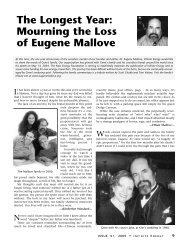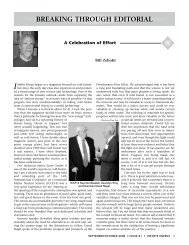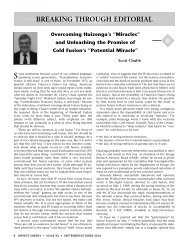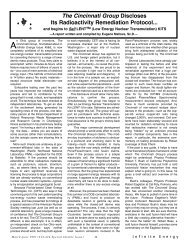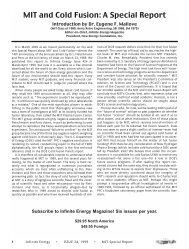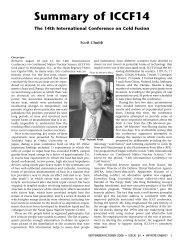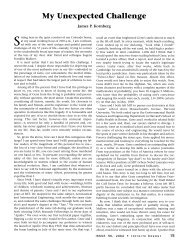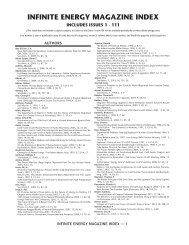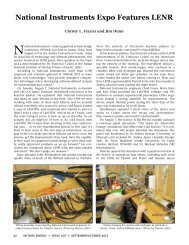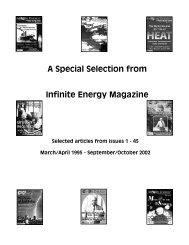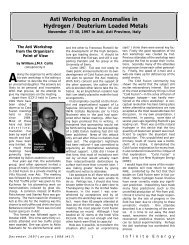Martin Fleischmann's Historic Impact - Infinite Energy Magazine
Martin Fleischmann's Historic Impact - Infinite Energy Magazine
Martin Fleischmann's Historic Impact - Infinite Energy Magazine
Create successful ePaper yourself
Turn your PDF publications into a flip-book with our unique Google optimized e-Paper software.
could remember. With his position on the committee and<br />
charge of a Max Planck Society in Germany, <strong>Martin</strong> now<br />
could have justified being called “famous” in February 1989.<br />
But by the end of March, he and Stan Pons were instead<br />
called “infamous” by U.S. physicists. “Anyone who dares…”<br />
Well, I had been with him in his thesis days and although<br />
we were not “friends” as many thought because they heard<br />
we were of the same alma mater, I still felt I had to do what<br />
I could. It happened that at the time I had 23 collaborators<br />
in my team so I was in a position to see if…<br />
Many of our first attempts failed but then in August 1989,<br />
Nigel Packham, a member in my group, came back from taking<br />
one of his samples to a technician in the nuclear group<br />
at Texas A&M who could analyze for tritium. “This one is<br />
full of tritium,” Packham reported. It meant a lot to all of us<br />
and to Fleischmann in particular.<br />
I tried to call <strong>Martin</strong> but he was not in. However, Mrs.<br />
Fleischmann was there and she repeated what she thought<br />
were my words, saying, “You’ve got chickens?” “That’s about<br />
it,” I said.<br />
It was a horrible period in our lives and I think in the life<br />
of science in America. I recall how my wife and I suffered.<br />
Most know that Mr. Toyoda, of the company Toyota, rescued<br />
<strong>Martin</strong> and Stan and set them up in a laboratory at IMRA<br />
(part of Technova Corporation, a subsidiary of Toyota) in<br />
France. Free from the controversy and attacks, in idyllic surroundings,<br />
<strong>Martin</strong> and Stan might well have been expected<br />
to have really made progress and quelled the doubts. At first,<br />
it seemed to go well. Fleischmann was keeping quiet but Stan<br />
Pons believed in publicity and kept the good news flowing.<br />
But then the good news ceased. “What caused the breakup?”<br />
people asked and I can only say that it seemed all the<br />
good results they had got before could not now be repeated.<br />
Fleischmann retired and returned to England. Pons, with<br />
support from a wealthy family, stayed in France.<br />
But <strong>Martin</strong> Fleischmann was not the kind of fellow who<br />
creeps away, beaten. He boldly pushed on in Bury Lodge in<br />
Tisbury soon after leaving France and he commenced a collaboration<br />
with Preparata, an Italian physicist who told me<br />
he was the greatest physicist in Europe! He worked theoretically<br />
on “cold fusion” and applied some thoughts which he<br />
said explained the earlier Pons and Fleischmann results.<br />
Fleischmann and Preparata saw very much together and had<br />
often spoken of quantum electrodynamics (QED). He, too,<br />
had a new theory which interpreted the earlier results. (It is<br />
unclear to me to what extent it was a new theory or was it<br />
following Preparata?)<br />
Fleischmann continued to appear at the yearly meetings<br />
on cold fusion, and made useful contributions, even at one<br />
event after it became known he was suffering from<br />
Parkinson’s disease.<br />
So when the bad news came, it was no surprise. He was<br />
controversial indeed, a brave and honest plow into the<br />
future. I have nothing to say about him that is not good.<br />
Dr. Melvin Miles<br />
(Retired, Naval Air Warfare Center Weapons Division<br />
at China Lake / Adjunct Faculty, University of La Verne)<br />
I first heard the 1989 Fleischmann-Pons announcement<br />
of cold fusion on the radio as I was driving to my work at the<br />
Naval Weapons Center at China Lake. I was already using<br />
7 INFINITE ENERGY • ISSUE 105 • SEPTEMBER/OCTOBER 2012<br />
palladium/hydrogen as a reference electrode in my research<br />
work as an electrochemist. My first reaction was how great<br />
this sounded and why had I not thought to do such experiments.<br />
Everything I needed for these experiments was<br />
already available at China Lake, and I started my own experiments<br />
that same weekend. I quickly realized that this was<br />
not a simple high school experiment done in a mason jar, as<br />
critics liked to describe it, but instead was very challenging.<br />
The major problem was to find an accurate method to do the<br />
calorimetry. David Stilwell, a post-doc student at China<br />
Lake, worked with me as we tried various calorimetric<br />
approaches. Within three months, we had found no excess<br />
power for either Pd/H 2 O or Pd/D 2 O, i.e. 0±4% excess power<br />
for each. I was getting telephone calls from a DOE representative<br />
about my experiments, and I reported no excess heat<br />
effects. After about six months, we tried a new palladium rod<br />
from Johnson-Matthey and found our first excess heat effect.<br />
I reported this to DOE, but I was still listed in the November<br />
1989 DOE Report with groups that found no excess heat or<br />
power.<br />
I first saw <strong>Martin</strong> Fleischmann and Stan Pons at the May<br />
1989 Electrochemical Society meeting in Los Angeles. David<br />
Stilwell and I arrived early to get a first row seat, but then<br />
they cleared the large conference room. We wound up stuck<br />
at the entry door as a huge crowd was pushing forward. This<br />
could have been a fatal situation, but then the doors were<br />
opened and we found our original front row seats. I was<br />
impressed by <strong>Martin</strong>’s handling of questions and criticisms<br />
and by his video that showed how quickly red coloration<br />
added to the cell becomes mixed in response to stirring<br />
issues.<br />
I next saw <strong>Martin</strong> Fleischmann at the first cold fusion<br />
conference (ICCF1) at Salt Lake City in 1990. I still only<br />
knew <strong>Martin</strong> from a distance, but I was again impressed by<br />
his skill in answering questions from critics who were obviously<br />
trying to ridicule cold fusion at this conference. I gave<br />
my first cold fusion presentation in Salt Lake that showed<br />
ample excess heat for the Johnson-Matthey palladium. I<br />
recall that Stan Pons quickly came over to congratulate me<br />
on my presentation. I later realized that my results were in<br />
excellent agreement with the F-P experiments. Several people<br />
commented that China Lake was the only group listed in<br />
the DOE Report for no excess heat that later reported excess<br />
heat effects. This was simply being honest and reporting<br />
what was found in my experiments.<br />
I came to know <strong>Martin</strong> better at ICCF2 in Como, Italy.<br />
There were no distractions from the news media or from critics<br />
at this conference. The reporting of important new<br />
results made this one of the best cold fusion conferences.<br />
In the following years, <strong>Martin</strong> began writing me long letters<br />
about calorimetry, such as errors in the Caltech, MIT and<br />
Harwell work. I incorporated some of this in my calorimetric<br />
paper published in the Journal of Physical Chemistry.<br />
I recall one long letter where <strong>Martin</strong> responded almost<br />
line by line to the NHE paper published in the Monaco<br />
ICCF5 proceedings that was critical of the F-P calorimetry.<br />
Although NHE used the F-P Dewar calorimeters, many mistakes<br />
were made in the NHE analysis of the data. In 1997-<br />
1998, I worked at NHE and used these same Dewar calorimeters.<br />
It became obvious to me that large mistakes were made<br />
by the NHE methods of analysis.<br />
In 1998 at the Vancouver ICCF7 meeting, <strong>Martin</strong> and I<br />
decided to work together on the analysis of the NHE data



